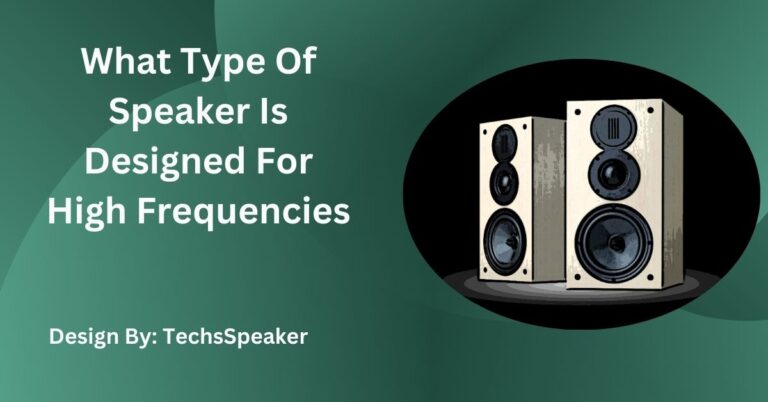How To Test Impedance Of Speaker – Complete Guide!
Testing a speaker’s impedance is essential for optimal audio performance. This guide covers the importance of impedance, necessary tools, step-by-step testing instructions, and troubleshooting tips for accurate results.
Testing the impedance of a speaker is crucial for ensuring your audio system works correctly and efficiently. Impedance, measured in ohms (Ω), affects how much power your amplifier can deliver to the speaker. This guide will provide all the information you need to test the impedance of a speaker accurately and in an easy-to-understand way.
Why Test Speaker Impedance?
Ensure Compatibility
Testing impedance helps you make sure your speakers will work well with your amplifier. If the impedance of the speaker does not match the amplifier, it can lead to poor sound quality or even damage your equipment. For example, connecting a 4-ohm speaker to an amplifier designed for 8-ohm speakers may cause the amplifier to overheat.
Improve Sound Quality
Having the correct impedance is important for achieving the best sound quality. When the speaker and amplifier are properly matched, the speaker receives the right amount of power, allowing it to produce clear and balanced sound. If your speaker is not getting enough power, it may sound weak or distorted.
Prevent Damage
When the impedance is not correctly matched, it can lead to problems for both the speaker and the amplifier. An overworked amplifier may fail, while an underpowered speaker can be damaged due to clipping or distortion. Testing the impedance regularly can help you avoid these issues.
Understanding Speaker Impedance:

What is Impedance?
Impedance is the resistance a speaker offers to the electrical current flowing from an amplifier. It combines resistance (R) and reactance (X) and is expressed in ohms (Ω). The impedance affects how much current flows through the speaker and how well it performs.
Nominal vs. Actual Impedance
Speakers usually come with a nominal impedance rating (like 4 ohms, 8 ohms, or 16 ohms). This rating is a general guideline and can vary depending on the frequency of the sound. Actual impedance may change with different frequencies due to the speaker’s reactive components, such as inductors and capacitors. Understanding this helps you match speakers and amplifiers effectively.
Why Impedance Matters
Matching the impedance of your speakers with your amplifier ensures efficient power transfer, better sound quality, and helps prevent overheating or damage. Using speakers with the correct impedance rating will make your audio system run more smoothly.
Tools Needed to Test Speaker Impedance:
Before you begin, gather these tools:
- Multimeter: A digital or analog multimeter is needed to measure the resistance and impedance.
- Speaker Cables: These will connect the speaker to the multimeter.
- Calculator (Optional): A calculator can help with any calculations you might need to do.
Step-by-Step Guide to Testing Speaker Impedance:
Step 1: Set Up Your Multimeter
- Turn Off the Power: Always turn off and unplug the speaker and amplifier before testing. This prevents electrical shock or damage to the equipment.
- Set the Multimeter: On the multimeter, set it to the ohms (Ω) setting. If your multimeter has different ranges, choose the lowest range to get the most accurate reading.
Step 2: Measure the Resistance
- Connect the Probes: Connect the multimeter probes to the speaker terminals. Put the red probe on the positive terminal and the black probe on the negative terminal. Ensure the connections are firm for accurate readings.
- Read the Multimeter: Look at the display on the multimeter. This number is the DC resistance of the speaker. Keep in mind that the actual impedance will be slightly higher than this reading.
Step 3: Calculate the Impedance
- Understand the Reading: The multimeter measures DC resistance, which is not the same as impedance. Impedance is usually 10-20% higher than the resistance reading due to the reactive components of the speaker.
- Estimate Impedance: To get an estimated impedance, multiply the resistance reading by 1.1 to 1.2. For example, if your multimeter reads 6 ohms, the impedance is likely between 6.6 and 7.2 ohms.
Also Read: Do It Yourself Speaker Stands – Everything You Need To Know!
Tips for Accurate Measurements:
Ensure Proper Connections
Make sure that the multimeter probes are securely connected to the speaker terminals. Loose connections can lead to inaccurate readings, which can mislead you about your speaker’s performance.
Measure Multiple Times
It’s good practice to take several measurements. Variations in readings can happen due to minor inconsistencies. By averaging multiple readings, you can get a more accurate estimate of the speaker’s impedance.
Understand Nominal Impedance
Speakers typically have a nominal impedance rating (like 4 ohms or 8 ohms). When you calculate the impedance, your result should be close to this nominal value. If it is significantly different, there may be an issue with the speaker.
Common Impedance Ratings:
4 Ohms
4-ohm speakers are popular in car audio systems because they can draw more power from the amplifier. They are designed to work with more powerful amplifiers, providing a stronger audio output.
8 Ohms
8-ohm speakers are standard in home audio systems. They are compatible with most amplifiers and receivers, making them a popular choice for general listening.
16 Ohms
16-ohm speakers are less common but are used in specific audio setups, especially in professional audio equipment. They require less current, which can be beneficial in certain scenarios.
Troubleshooting Impedance Issues:

Inconsistent Readings
If your multimeter shows inconsistent readings, check the connections. Ensure the probes are securely attached to the speaker terminals. If needed, clean the terminals to improve contact.
No Reading
If the multimeter shows no reading, there might be a break in the speaker wire or a problem with the multimeter. Check all connections and try testing the multimeter with a known resistor to ensure it is functioning properly.
Impedance Too Low or High
If the impedance reading is significantly different from the expected nominal value, there could be an issue with the speaker’s internal components, such as the voice coil or diaphragm. In this case, consider consulting a professional for further inspection and repair.
Safety Precautions:
Turn Off Power
Always ensure that your audio equipment is turned off and unplugged before you start testing to avoid electrical shocks or damage to the device.
Handle Speakers Carefully
Be gentle while handling your speakers, as they contain delicate components that can be easily damaged. Place them on a stable surface to avoid dropping or damaging them during testing.
Use the Correct Settings
Make sure your multimeter is set to the correct ohm range. Using the wrong setting can damage the multimeter or provide inaccurate readings.
FAQs:
1. What is speaker impedance?
Speaker impedance is the resistance that a speaker offers to the electrical current from an amplifier, measured in ohms. It affects the power transfer and sound quality.
2. Why should I test speaker impedance?
Testing speaker impedance ensures compatibility with your amplifier, improves sound quality, and prevents potential damage from incorrect power delivery or overheating.
3. How do I measure speaker impedance?
To measure speaker impedance, use a multimeter set to the ohm setting. Connect the probes to the speaker terminals, read the resistance, and estimate the impedance.
4. What if my impedance reading is inconsistent?
Inconsistent readings may indicate loose connections or dirty terminals. Ensure firm connections and clean the terminals to improve contact for accurate measurements.
5. What are common impedance ratings for speakers?
Common impedance ratings include 4 ohms (for car audio), 8 ohms (standard for home audio), and 16 ohms (used in professional setups). Each rating suits specific applications.
Conclusion
Understanding how to test speaker impedance is vital for maintaining an efficient audio system. Proper impedance matching ensures compatibility with your amplifier, improves sound quality, and helps prevent damage. Following the guidelines in this article will enable you to measure impedance accurately and troubleshoot common issues. Regularly checking your speakers will enhance your listening experience, ensuring you get the best performance from your audio setup.







